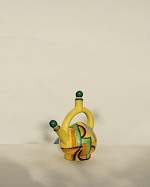Schramberger Majolikafabrik, founded in 1820 in the heart of Germany’s Black Forest by Isidor Faist, stands as a testament to the enduring power of craftsmanship and innovation. Over nearly two centuries, this iconic ceramic factory became renowned for its exceptional artistry and forward-thinking designs, achieving international recognition particularly during the 1920s. Under the direction of brothers Moritz and Leopold Meyer, the factory evolved from its traditional roots into a modern powerhouse of ceramic production, blending utility with unparalleled aesthetic vision.
What truly set Schramberger apart was its ability to attract and collaborate with some of the most influential designers of the time. Visionaries like Eva Zeisel and Elfriede Stadler brought their unique perspectives to the factory, shaping pieces that were not just functional but works of art in their own right. Their contributions helped define Schramberger’s distinct modern style—a harmonious marriage of form and function that remains revered by collectors and design enthusiasts to this day.
But like many great stories, Schramberger’s narrative is not without its struggles. The tumult of World War II and the challenges of post-war recovery proved insurmountable. Despite valiant efforts to rebuild and regain its former prominence, the factory ultimately faced liquidation in 1988/89, signaling the end of an era.
Yet, the spirit of Schramberger Majolikafabrik lives on. While the factory itself may no longer operate, its legacy endures in the lasting influence it had on the ceramic world. Today, its pieces continue to be celebrated for their beauty and craftsmanship, a living reminder of the factory’s role in shaping the landscape of 20th-century design.

